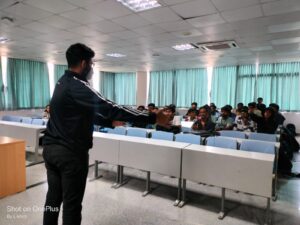Announcements >>
Announcements >>
Course: Introduction to Python Programming (BPLCK205B)
Faculty Name: Dr. Annie Sujith, Associate Professor, Dept. of CSE
During the Python workshop conducted on July 21, 2023, for the 2nd-semester B-section students, the resource person, Dr. Annie Sujith, implemented a series of interactive activities and educational games. Recognizing that students might typically be tired and eager to return home at the end of the day during the workshop, the resource person decided to conclude with a fun and educational activity. Here’s how this engaging activity unfolded:
1) Team Division: The entire class was divided into two teams, with each team starting with 0 points. For instance, during this particular workshop, two teams were formed: the Boys’ team and the Girls’ team.
2) Placards: The resource person had prepared placards on the laptop in advance using software like MS Word or PowerPoint. Each placard displayed a Python language keyword, or existing module name, or function name.
(Examples of words for placing on placards: Python functions: input(), range(), max(), lower(), str(), sort() etc , Python keywords: continue, def, if then else, while, for, break, continue, TRUE etc, Python module names: shelve, pprint, random, os, sys, datetime, math, pandas, json, requests, numpy)
3) Acting and Guessing: Alternatively, from each team, one student would step forward, look at the placard on the resource person’s laptop, and then attempt to convey the word or term to their team members without using any spoken words or lip movement. They had a limited time of one minute for their team to guess the word correctly.
4) Scoring: If the team members successfully guessed the word on the placard within the given time, their team would earn a point. However, if the other team managed to guess the word once the time had expired, they would earn half a point.
The benefits of this activity are listed below:



+91 90711 17475
+91 9535423635
+91 9900529066
info@jyothyit.ac.in
Copyright © 2024 Jyothy Institue of Technology